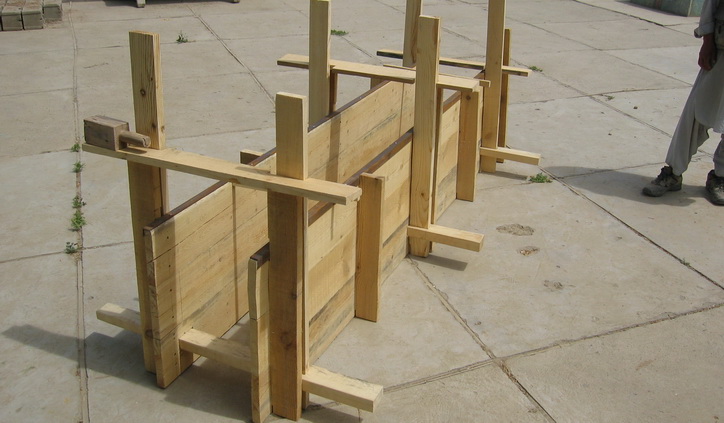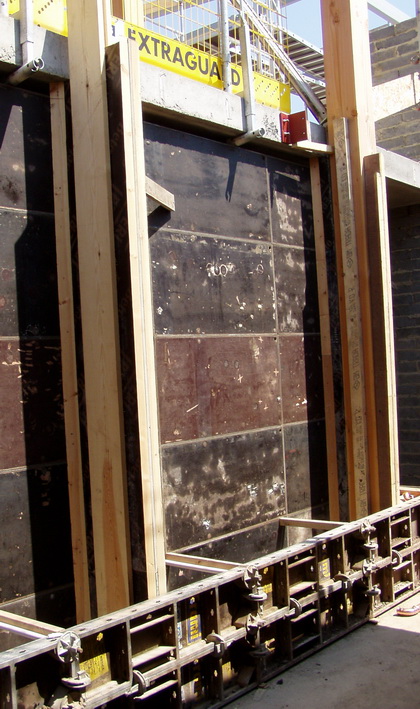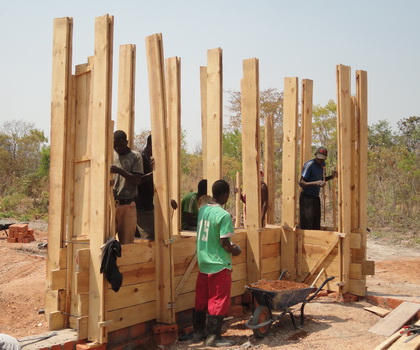|
Formwork is the basis of rammed earth. Formwork allows
a loose material to be placed directly into a wall with no
intermediate steps apart from mixing. Although there has been some
work done with pre-fabrication recently the advantage of building in-situ is homogenous walls from materials which are lower specification
than for bricks or blocks.
There are essentially two types of formwork, a movable
type and a static type. Moveable means each formwork assembly is
filled, disassembled and then set up again. Typically a building will
be built horizontally, with the first course being completed before
the second is begun.
Static formwork by contrast normally rises vertically
to between 2m-4m. Care has to be taken in the assembly and disassembly
but generally this is a rapid way to build. It allows the use of
system built formwork which may be hired or bought.
Moveable, horizontal formwork.
This type of formwork is found across the world, very
similar typology from Morocco to Peru, France to Afghanistan and
Bhutan to Australia. Traditionally it is carpenters who assemble a
formwork and a ramming team, as they are the ones who understand the
tooling.
|
|
 |
|
Much of the skill in moving formwork is in the rapid
assembly and disassembly of the basic components. Its also in the
choice of materials which must be strong enough not to deform or break
while at the same time being light enough to be manoeuvrable. The
fixings between the two sides need be both strong enough to control
the loads but also not too fiddly or liable to jam. Many systems
use wedges to tighten and untighten and for adjusting plumb. Threaded
rods are also used to good effect, but these can be more time
consuming than simple rope ties and tourniquet's.
The most common material for this type of formwork is
timber. It has both the strength and flexibility as well as elasticity
that however often it is twisted out of shape it keeps springing back.
Modern timber materials like plywood have these same characteristics
although they may lose surface quality quicker than timber. Composites like chipboard and strand board are to be avoided unless
the effect of bulging and splintering surface finish is the desired
one.
One material which works very well is timber scaffold
planks. Regular in shape and size, 35mm thick and evenly graded these
boards either new or second hand take a lot of beating. A set of
moveable forms would have a lot of life in them.
Steel formwork also works but the relationship between
weight and strength has to be carefully assessed. Although ramming may
take place manually, building up layers centimetres at a time the
overall effect is to produce a lot of pressure. While the formwork
contains it there is no problem. As soon as the pressure begins to
deform the sides there is no going back and with steel this mean the
steel is bent once and for all.
System formwork as shown can also be used as moving
formwork, panels which are 1.2m long by .6m high each weigh 35kg and
so are just about man-handleable. With steel ribs which are 90mm deep
and a 15mm epoxy resin bonded face they are very resilient. However
they are heavy and the smooth finish can lead to issues with removing
them from fresh work.
Formwork leaves its mark on rammed earth, timber grain
is often clearly visible on walls that can be a hundred years old. For
this reason it is worth considering the material the form sides are
|
|
 |
|
With system formwork it
may also be possible to slip form, that is take the bottom layer of
formwork off and slide it up to the top. The weight of the formwork
and the speed of drying of the material are all important when doing
this. It is also recommended that no less than three lifts of formwork
be used to ensure lower layers don't bite into the fresh built wall.
Hybrid formwork
In China and in Serbia there is another
kind of formwork which slip forms in a different way, using vertical
fixed sections to contain movable form sides. Once the vertical
sections are fixed the work proceeds very quickly, with very long
sections being rammed as a single piece with no joins.
More recently we have been using a
hybrid of this system fully boarded, not slip formed, but in shorter
static setups, see image at bottom. So formwork has a lot of potential solutions, what is
described above covers most of the options so far, but by no means all
of the myriad differences in detail.
Finally we have also done some work
with textile formwork, but that's another story... |
|
made from. In China
for instance there are traditional formworks which use stiff
basketwork sides, these give a rough surface very good for plastering
but may also be pleasant to look at.
Static formwork
Static formwork really comes from the
concrete industry. Separate elements are built up to make a single
large section. In concrete work the whole thing is assembled before
the liquid is poured in, with rammed earth the sections are assembled
as the work proceeds, allowing access into the formwork for people, materials
and rammers. With thicker walls the sections may be built up higher,
in a formwork which is 400mm wide or more there is room to manoeuvre
but with walls that are 300mm thick a formwork higher than 900mm
becomes awkward. The advantages
of static formwork are that the more vulnerable vertical and
horizontal joins in moving formwork are now contained in an ever
expanding box, so finish is easier to control. Also the major setting
up is in the first lift, the formwork which follows more or less just
clips on. |
|
 |
|
|